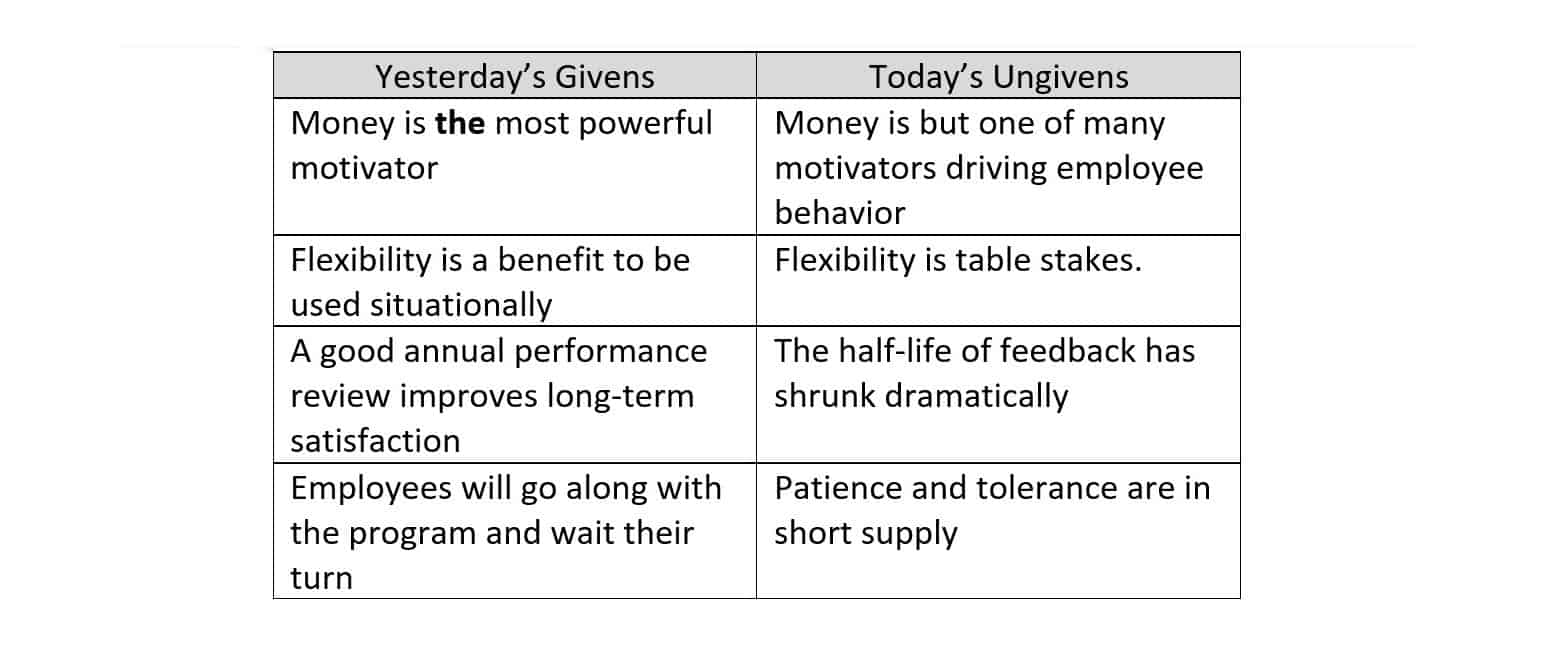
Despite recent high-profile examples of rescinded offers, it’s still a seller’s employment market with two jobs for every unemployed American. And even as inflation rages and economic contraction looms, retention remains a pressing issue. In fact, in a study, 87% of human resources leaders identified it as a #1 priority for the next several years.
Organizations and leaders have been forced to ‘pivot’ on so many fronts over the past two-and-a-half years. New business models. Creative delivery platforms. Distributed workforce configurations. So much has changed. But, in many cases, what hasn’t kept pace is our thinking around employee sentiment. The ‘givens’ of days gone by – those moldy mental models and myths – must give way to today’s ‘ungivens’ and the reality of the 2022 workplace. And until we confront these outdated assumptions, we may continue to grapple with untenable levels of attrition.
Here are just a few examples…

Money
Once considered a primary motivator of workplace behavior, is no longer the panacea for many problems. Throwing additional dollars at employees isn’t necessarily enough to keep top talent (or any talent at all for that matter.)
Make no mistake, employees still expect to earn a fair wage; but they’re looking for more from their work and the organizations for which they work. They want a sense of purpose – and are 27% more likely to stick around if they believe their employer has a purpose beyond simply making a profit. They also want a prosocial agenda. In fact, 79% of people report that they would refuse an offer from an organization known to not take action against sexual harassment… even if it came with a higher salary.
Want to move beyond old givens about what motivates people? Ask yourself:
- How well do you understand what motivates each of your employees?
- When was the last time you discussed the organization’s purpose and your employees’ role in achieving it?
- How might you learn more about what dimensions of the organization, culture, or work are positively ‘sticky’ for your employees?
Flexibility
A perk previously reserved for few and shared sparingly based upon individual circumstances – is quickly becoming the new currency of retention. You’ve likely seen it in action. A job interview cut short by the candidate when they learn that remote work is off the table. Or a new hire quitting during their first week of traveling to and from the workplace. Or a seasoned employee choosing to leave because the organization has simply not earned their commute back to the office.
Organizations that offer remote work enjoy 25% lower turnover and drastically reduced (up to 1/3) time to hire new staff members. So, finding ways to enable greater autonomy over the ‘where’, ‘when’, and ‘how’ of work is not just good for people – it’s good for business as well.
You can trade in yesterday’s flexibility givens by asking yourself:
- How do you really feel about remote and hybrid work? How might your feelings affect your relationship with workplace flexibility?
- Are you doing all you can to enable the autonomy your employees desire?
- Beyond just ‘where’, what other dimensions of work might offer employees opportunities for flexibility?
Recognition and Feedback
In many organizations, recognition and feedback are hugely under-utilized retention levers. According to research from McKinsey, 52% of the employees who recently left their jobs reported feeling undervalued by their manager. And employees who don’t feel recognized for their contributions are nearly twice as likely to be looking for another role.
That’s why so many organizations are turning away from ‘one and done’ approaches to recognition and feedback. They’re ditching (or supplementing) annual appraisals with generous portions of informal, on-the-spot, organic conversation about performance and development. This kind of ongoing dialogue builds rapport, demonstrates care, and generates positive feelings that lead to retention.
Lean into this ungiven by asking yourself:
- To what extent do your employees feel genuinely valued by you?
- When was the last time you offered impromptu feedback to an employee?
- How can you ensure a steady stream of the recognition and feedback employees crave?
Patience
Patience was a job requirement in the past. People ‘paid their dues’ and ‘put in their time’ as a prerequisite for earning promotions, additional responsibilities, and perks. It was an investment in one’s future. But the loyalty contract was nullified decades ago. And employees – not just the younger ones – know all too well how quickly things change and that tomorrow holds no promises. As a result, employees are looking to ensure that today’s experience meets their needs. If it doesn’t, they have options – that they are willing to exercise quickly.
This means that organizations may not enjoy the grace and tolerance of the past. Minor irritants can become issues. Frustrations may compound and build more quickly than in the past. Waiting for things to be better is less tolerable. Leaders who place importance on small things, as well as the present moment, may find themselves better prepared to help people thrive in today’s environment.
Embrace this ungiven by asking yourself:
- How well prepared are you to address the obstacles and roadblocks employees face?
- What steps are you taking to ensure an attractive (and retention-inspiring) employee experience?
- How compelling is your onboarding process and how quickly do you capture the imagination of new employees?
Old givens are giving way to new ungivens. And leaders who challenge their assumptions will be able to change with the times, meet the moment, and offer the employee experience that leads to greater satisfaction, retention, and results.
This article was originally published on SmartBrief.
